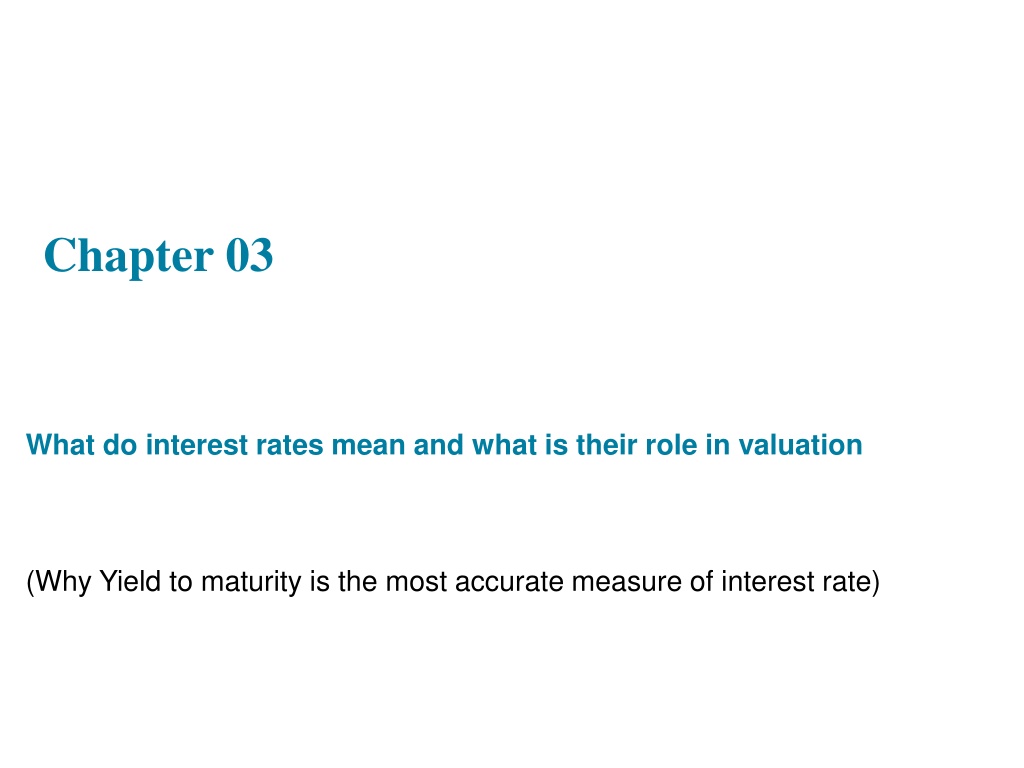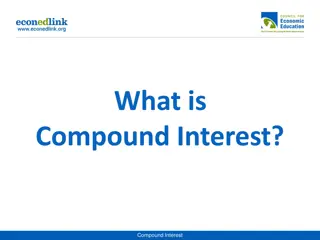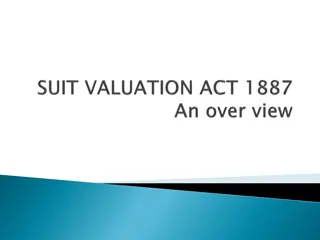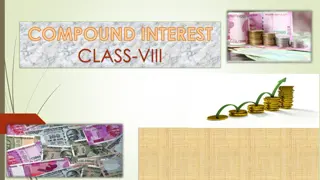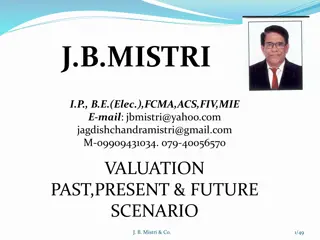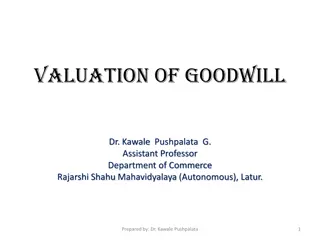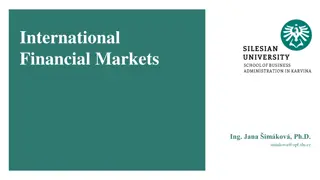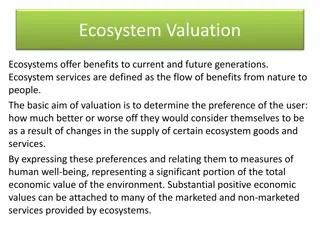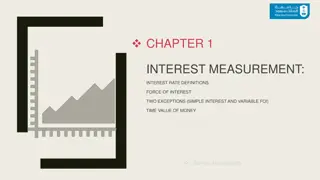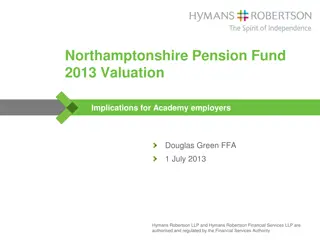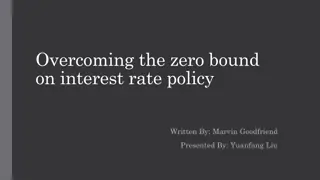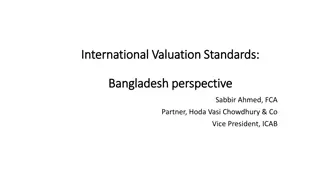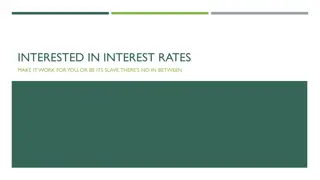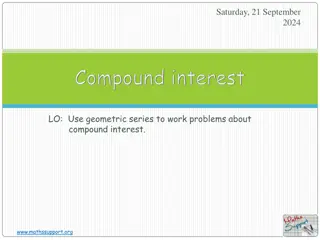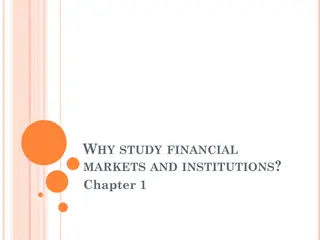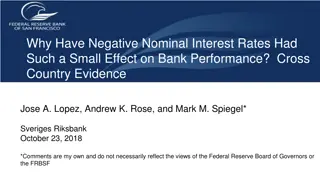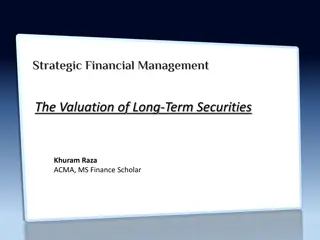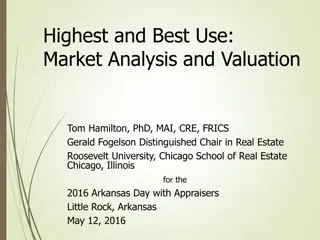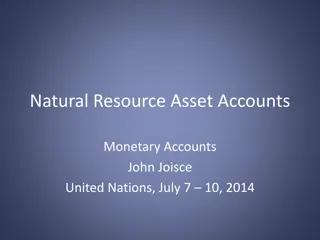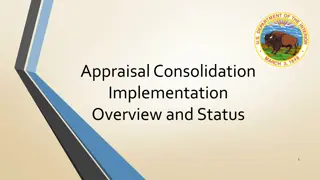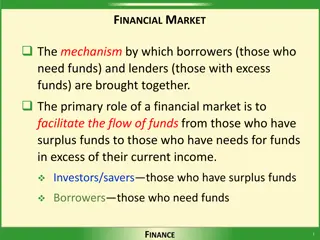Understanding Interest Rates and Valuation in Financial Markets
Explore the meaning and significance of interest rates in financial valuation, focusing on the concept of yield to maturity as a crucial measure. Learn how present value calculations and different types of credit market instruments play a role in determining interest rates and influencing investment decisions.
Download Presentation

Please find below an Image/Link to download the presentation.
The content on the website is provided AS IS for your information and personal use only. It may not be sold, licensed, or shared on other websites without obtaining consent from the author. Download presentation by click this link. If you encounter any issues during the download, it is possible that the publisher has removed the file from their server.
E N D
Presentation Transcript
Chapter 03 What do interest rates mean and what is their role in valuation (Why Yield to maturity is the most accurate measure of interest rate)
Learning Objectives Calculate the present value of future cash flows and the yield to maturity on the four types of credit market instruments. Recognize the distinctions among yield to maturity, current yield, rate of return, and rate of capital gain. Interpret the distinction between real and nominal interest rates.
Measuring Interest Rates Present value: a dollar paid to you one year from now is less valuable than a dollar paid to you today. Why: a dollar deposited today can earn interest and become $1 (1+i) one year from today. To understand the importance of this notion, consider the value of a $20 million lottery payout today versus a payment of $1 million per year for each of the next 20 years. Are these two values the same?
Present Value Let i = .10 In one year: $100 (1 + 0.10) = $110 In two years: $110 (1 + 0.10) = $121 or $100 (1 + 0.10)2 In three years: $121 (1 + 0.10) = $133 or $100 (1 + 0.10)3 In n years $100 (1 + i)n
Simple Present Value (1 of 2) PV = today s (present) value CF = future cash flow (payment) i = the interest rate CF = PV + n (1 ) i
Simple Present Value (2 of 2) Cannot directly compare payments scheduled in different points in the time line
Four Types of Credit Market Instruments Simple Loan Fixed Payment Loan Coupon Bond Discount Bond
Yield to Maturity Yield to maturity: the interest rate that equates the present value of cash flow payments received from a debt instrument with its value today
Yield to Maturity on a Simple Loan PV = amount borrowed = $100 CF = cash flow in one year = $110 = number of years = 1 n $110 (1 + ) $100 = 1 i (1 + ) $100 = $110 i $110 (1 + ) = $100 = 0.10 = 10% i i For simple loans, the simple interest rate equ yield to maturity als the
Fixed-Payment Loan The same cash flow payment every period throughout the life of the loan LV = loan value FP = fixed yearly payment n = number of years until maturity FP 1 + FP FP FP LV = + + + . . . + 2 3 (1 + )n i (1 + ) i (1 + ) i i
Coupon Bond (1 of 6) Using the same strategy used for the fixed-payment loan: P = price of coupon bond C = yearly coupon payment F = face value of the bond n = years to maturity date C C C C F P = + + +. . . + + 2 3 n n 1+ i (1+ ) i (1+ ) i (1+ ) i (1+ ) i
Coupon Bond (2 of 6) A coupon bond is identified by four pieces of information: 1. Face value 2. Agencies that issue this bond 3. Maturity date 4. The coupon rate Source: https://en.wikipedia.org/wiki/United_States_Treasury_security
Coupon Bond (3 of 6) When the coupon bond is priced at its face value, the yield to maturity equals the coupon rate. We can show the statement by using simple algebra: ? =? ? 1 + ?+ 1 1 + ?1 ? ? 1 + ?2+ ? ? 1 + ?3 + 1 1 + ? 1 1 + ? ? = ? ? 1 + ?? ? 1 1 1 + ??? = ? ? if ? = ? 1
Coupon Bond (4 of 6) The price of a coupon bond and the yield to maturity are negatively related. The yield to maturity is greater than the coupon rate when the bond price is below its face value.
Coupon Bond (5 of 6) Table 1 Yields to Maturity on a 10%-Coupon-Rate Bond Maturing in Ten Years (Face Value = $1,000) Price of Bond ($) 1,200 1,100 1,000 900 800 Yield to Maturity (%) 7.13 8.48 10.00 11.75 13.81
Coupon Bond (6 of 6) Consol or perpetuity: a bond with no maturity date that does not repay principal but pays fixed coupon payments forever ??= ?/?? ??= price of the consol ? = yearly interest payment ?? = yield to maturity of the consol One can rewrite the equation as: ??= ?/?? For coupon bonds, this equation gives the current yield, an easy to calculate approximation to the yield to maturity
Discount Bond For any one year discount bond F P = i P F = Face value of the discount bond P = Current price of the discount bond The yield to maturity equals the increase in price over the year divided by the initial price. As with a coupon bond, the yield to maturity is negatively related to the current bond price.
The Distinction Between Interest Rates and Returns (1 of 4) Rate of Return: The payments to the owner plus the change in value expressed as a fraction of the purchase price C RET = + P RET = return from holding the bond from time to time + 1 P = price of bond at t P = price of the bond at time + 1 C = coupon payment C = current yield = P P P = rate of capital gain = P t + P t P 1 t P t t t t time t t + 1 t i c t + 1 t t g
The Distinction Between Interest Rates and Returns (2 of 4) The return equals the yield to maturity only if the holding period equals the time to maturity. A rise in interest rates is associated with a fall in bond prices, resulting in a capital loss if time to maturity is longer than the holding period. The more distant a bond s maturity, the greater the size of the percentage price change associated with an interest- rate change. Interest rates do not always have to be positive as evidenced by recent experience in Japan and several European states.
The Distinction Between Interest Rates and Returns (3 of 4) The more distant a bond s maturity, the lower the rate of return the occurs as a result of an increase in the interest rate. Even if a bond has a substantial initial interest rate, its return can be negative if interest rates rise.
The Distinction Between Interest Rates and Returns (4 of 4) Table 2 One-Year Returns on Different-Maturity 10%-Coupon- Rate Bonds When Interest Rates Rise from 10% to 20% (1) (2) (3) (4) (5) (6) Years to Maturity When Bond Is Purchased Initial Current Yield (%) Initial Price ($) Price Next Year* ($) Rate of Capital Gain (%) Rate of Return [col (2) + col (5)] (%) 30 10 1,000 503 49.7 39.7 20 10 1,000 516 48.4 38.4 10 10 1,000 597 40.3 30.3 5 10 1,000 741 25.9 15.9 2 10 1,000 917 8.3 +1.7 1 10 1,000 1,000 0.0 +10.0 *Calculated with a financial calculator, using Equation 3.
Maturity and the Volatility of Bond Returns: Interest-Rate Risk Prices and returns for long-term bonds are more volatile than those for shorter-term bonds. There is no interest-rate risk for any bond whose time to maturity matches the holding period.
Calculating Duration (duration is a weighted average of the maturities of the cash payments)
The duration calculation done in Table 3.3 and 3.4 can be written as follows NOTE: All else being equal, the longer the term to maturity of a bond, the longer its duration. All else being equal, when interest rates rise, the duration of a coupon bond falls. All else being equal, the higher the coupon rate on the bond, the shorter the bond s duration.
Duration of a portfolio of the two securities is just the weighted average of the durations of the two securities, with the weights reflecting the proportion of the portfolio invested in each. Example: A manager of a financial institution is holding 25% of a portfolio in a bond with a five-year duration and 75% in a bond with a 10-year duration. What is the duration of the portfolio? Solution: The duration of the portfolio is 8.75 years. (0.25 x 5) + (0.75 x 10) = 1.25 + 7.5 = 8.75 years
Duration and Interest-Rate Risk Duration is a good approximation, particularly when interest-rate changes are small, for how much the security price changes for a given change in interest rates.
The Distinction Between Real and Nominal Interest Rates Nominal interest rate makes no allowance for inflation. Real interest rate is adjusted for changes in price level so it more accurately reflects the cost of borrowing. Ex ante real interest rate is adjusted for expected changes in the price level Ex post real interest rate is adjusted for actual changes in the price level
Fisher Equation = + e i i r = nominal interest rate = real interest rate r i i e = expected inflation rate When the real interest rate is low, there are greater incentives to borrow and fewer incentives to lend. The real inter est rate is a better indicator of the incentives to borrow and lend.
